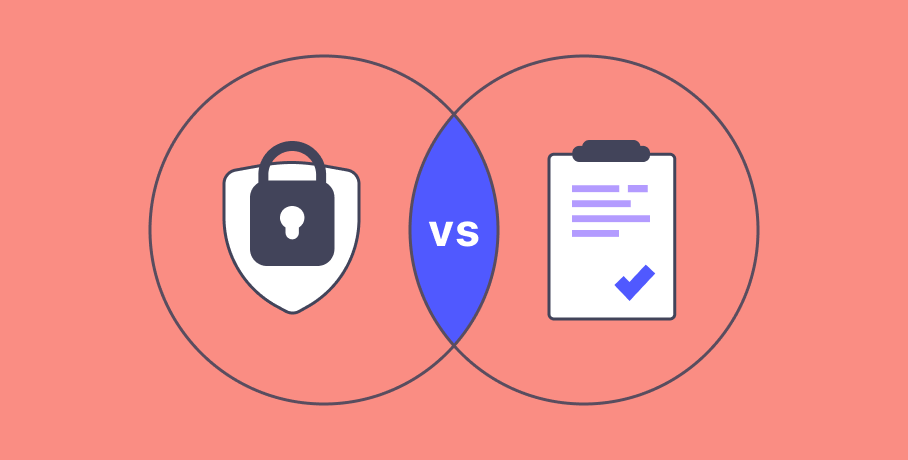Compliance and SDLC security are closely linked. Both share a commonality: managing risk. Though the two are used interchangeably, compliance is not necessarily security. You can be compliant but not secure. This post will explain the differences between compliance vs. SDLC security and why both are important for your business. Let’s dive in.
What Is Software Security?
Software security refers to techniques applied during the software development lifecycle (SDLC) to protect applications from unauthorized access, use, or destruction. Such methods protect data while in transit and at rest and help protect against system vulnerabilities like malware and ransomware attacks.
In other words, software security ensures your applications are secure from end to end and, in worse cases, remain functioning under a malicious attack.
Software Security Techniques
Two-factor authentication and understanding your software pipeline to identify vulnerabilities early so they can be addressed immediately are some examples of software security techniques. Other techniques include:
- Regularly patch your systems and software to fix security vulnerabilities.
- Regular code reviews, whether manual, automated, or both, to help find vulnerabilities and other errors.
- Use a firewall to protect your computer from unauthorized access.
- Limiting administrative privileges for a smaller attack surface, minimizing the risk of a data breach.
- Encrypt your data at rest and in transit to keep prying eyes at bay.
- Training employees on best practices during the SDLC so code is built and deployed with security in mind.
Software security is an active, continuous process throughout your SDLC. Code is deployed to production with security in mind, making it safer for the end user and your company.
What Is Compliance?
Compliance is the act of meeting the minimum requirements of a set of regulatory standards. Think ISO certifications, SOC 2, GDPR, and PCI regulations.
Whether mandatory or voluntary, depending on your industry and governing bodies, there are a set of rules and requirements you must follow, and now and then, you go through an audit to verify you are still in compliance. A SOC 2 audit, for example, looks at five areas or “trusted principles” either at a point in time for a Type I audit or over a period of time for a Type II audit:
- Security: Considers if applications and systems are protected against unauthorized access.
- Availability: Checks if services meet minimum uptime requirements as spelled out in a Service Level Agreement (SLA).
- Processing Integrity: Looks at whether systems return data requested and if the data is complete, valid, accurate, timely, and authorized.
- Confidentiality: Looks at whether access to sensitive data is restricted.
- Privacy: Considers if the collection, use, retention, disclosure, and disposal of personal information match what your company’s privacy notice states.
In other words, compliance tells you whether you meet a given standard, but not how well or if your systems and applications are protected.
SDLC Security vs. Compliance
Notice that compliance checks to see if you are doing something and not necessarily how well you are doing it. Processing Integrity, for example, doesn’t consider the integrity of the data. You may still be compliant if there is an issue with your software pipeline or code that results in bad data. For example, if the process returns a name, you are compliant even though it may be the wrong name.
While both security and compliance work to mitigate risk, they do so in different ways. A third party, usually a government or regulatory agency, determines whether you’re compliant. Everyone gets the same playbook and the same checklists. At the time of an audit, you can check things off the list. Do you have a firewall? Check. Did all employees complete an annual cybersecurity education course? Check. Do you run routine backups? Check. Great, you comply.
Software security is a continuous process of monitoring, intercepting, mitigating, and defending against ever-evolving threats throughout your SDLC. Bad actors don’t simply target one or two applications. They go after your networks, systems, developer environments, applications, devices, employees, and whatever angle they can find to get past your defenses. Threats change as bad actors learn your system defenses and work to find holes or unexploited weaknesses, continually keeping you on your toes.
Balancing Compliance and SDLC Security
Remember that compliance and security both serve to manage and mitigate risk. The terms are not synonymous and function differently but do work together to help protect your business against cyber threats.
Compliance provides clarity on the minimum standards and requirements to protect data while software security is an active, continuous process as part of your SDLC, and evolves and adapts as threats evolve and adapt.






)

